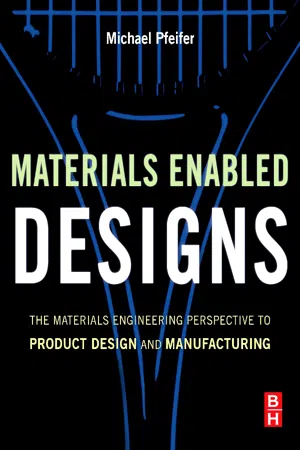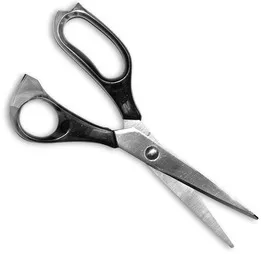1.1. Introduction
A person can look at any engineered product and see that it is made of a wide variety of materials that have been manipulated into a wide variety of shapes for the purpose of enabling specific product features. Just consider an automobile with its painted steel body, plastic knobs, rubber tires, and glass windows, or a computer mouse with its plastic shell and buttons and rubber tracking ball and wheel, or a bicycle with its painted aluminum frame, steel gears and chain, and foam padded and plastic covered seat. In fact, a product can be considered to be a collection of materials such as metals, polymers, ceramics, composites, and semiconductors. Furthermore, the materials used in a product account for up to 60% of the total cost to manufacture a product (Nevins & Whitney, 1989). Based on both of these facts, it seems that the engineering processes for selecting the materials used in a product and the means by which the properties of the materials are controlled are of the utmost importance to the success of a product.
Even though the materials used in a product have a huge impact on its performance, reliability, and cost, many companies vastly undervalue the importance of proper materials engineering considerations for product development and manufacturing decisions. Consequently, these companies struggle with problems such as new products that are behind schedule, cost overruns, poor supplier quality, poor manufacturing quality, and products that do not work as expected. All of these problems have a negative effect on the success of a product and a company's competitiveness. These struggles do not have to be accepted as a normal part of doing business. In many cases, product development and manufacturing problems, and their costs, can be avoided if comprehensive materials engineering considerations are employed when making certain design and manufacturing decisions.
A successful product enjoys good profits, good market share, and good customer satisfaction. Developing and manufacturing a successful product requires the following:
▪ That the product has the performance and reliability to satisfy the wants and needs of the intended customer
▪ That the costs to develop and manufacture the product are within budget
▪ That the product is released to the market on time
Meeting the first two requirements depends on a design team's ability to select materials that enable the product to satisfy its performance, reliability, and cost requirements. Furthermore, controlling the variation of the properties of the materials is critical for making a product that consistently meets its performance and reliability requirements while keeping manufacturing costs within budget. Releasing a product to market on time depends on avoiding delays associated with problems with the materials.
In short, this book asserts that a product's success depends on the attention paid to the materials engineering aspects of decisions that occur during product development and manufacturing.
It is not the intention here to diminish the role of other engineering perspectives or to imply that materials engineering alone can solve all the problems encountered during product development and manufacturing. The materials engineering perspective is just one perspective of many that are required to make good decisions that increase the likelihood of producing a successful product. However, it is the intention of this book to instill a better appreciation for the role that the materials engineering perspective can play in product success.
1.2. The Materials Engineering Perspective
This book teaches a perspective that focuses on materials engineering concerns as they pertain to achieving overall product success. This perspective, referred to here as the materials engineering perspective, is based on the following three considerations:
1. The performance, reliability, and cost of a product are highly dependent on the properties of the materials that make up the product.
2. Proper selection of the materials used in a product is crucial to satisfy its performance, reliability, and cost requirements.
3. Control of the variation of the properties of the materials that make up a product is crucial for enabling its consistent performance, reliability, and cost.
The first consideration is important because it shifts the attention away from viewing any single component within a product solely in terms of its mechanical, electrical, optical, or chemical functionality. Instead, seeing a component in terms of its materials moves attention to the properties of the materials required to obtain the desired functionality and reliability at the desired cost.
The second consideration may seem obvious because most engineers recognize that specific materials have specific applications and that the optimum materials must be selected for any given application. However, the proper selection of materials demands thorough and accurate knowledge of all of a product's performance, reliability, and cost requirements. Many design teams make the mistake of trying to select materials without knowing all the selection criteria and based on inaccurate criteria. Furthermore, there are selection criteria that are based on requirements in addition to performance, cost, and reliability. For example, industry standards, government regulations, intellectual property rights, and manufacturing constraints place requirements on a product's design. This is discussed in more detail in Chapter 2.
The third consideration about the control of material properties is based on the fact that there are many sources of variation of the properties of the materials used in a product. The sources of variation are related to the processes used to manufacture a product and the materials used in the processes. Controlling variations requires an understanding of the relationship between a manufacturing process, the properties of materials used in the process, and the properties of the material that makes up the process output. Excessive variations in the materials’ properties result in products that cannot be easily manufactured and do not have the desired performance and reliability. This is discussed in more detail in Chapter 5.
Looking at a product from the materials engineering perspective can help design teams frame decisions and understand the information required to make better design and manufacturing decisions. An example of the application of this perspective can be provided through consideration of the scissors shown in Figure 1.1. From just a functional perspective, the scissors is a mechanical device capable of cutting paper. From a materials engineering perspective, the scissors is a set of materials that must have certain properties, such as the following.
▪ Two pieces of corrosion-resistant material hard enough to maintain a sharp edge and ductile enough so as not to fracture when used to pry something open
▪ Handles rigid enough to transfer a user's force to the blades, but with enough strength and impact resistance so that they do not crack or break when the scissors are used or dropped
▪ A pivot pin made of a hard, corrosion-resistant material with a...

